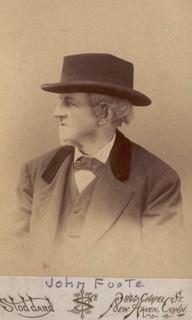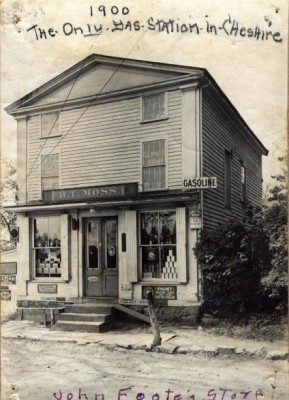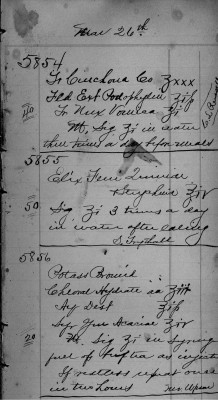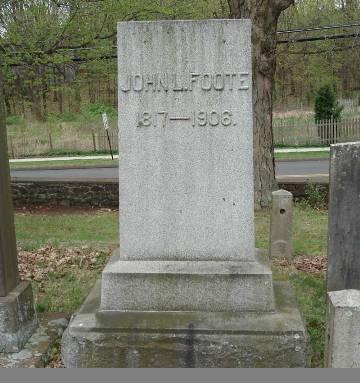John Lambert Foote was for most of the 19th century the only pharmacist operating a drug store in Cheshire, CT. He died in 1906, leaving an estate of some 420,000 dollars – a tribute not only to his business acumen, but his shrewdness in investing in stocks and bonds. He was not only a witness to the scientific advances in his profession of pharmacy over the century, he was also an active participant. This is his story.
The Connecticut Business Directory for 1874 lists all the druggists in Connecticut. There is only one listing for Cheshire: John L. Foote. Born in Cheshire on September 14, 1817, John Lambert Foote was one of six children of Dr. William Lambert Foote and Mary Scoville. Dr. William Lambert Foote in turn was a son of Reverend John Foote (1742-1813), the second pastor of the Cheshire Congregational Church. Dr. Foote, besides his practice as a physician, also served as Town Clerk, and was elected First Judge of Probate for Cheshire. In addition, Dr. Foote established a drug store on the corner of what is now Wallingford Road and Main Street. The store was next door to the William Keeler stove shop and the Keeler home. Dr. Foote’s son John L. enlarged that store and operated it for the remainder of his long life.

Dr. John Foote, Cheshire pharmacist
Introduction:
The use of remedies for illness and injuries has been with us for millennia. Chinese Traditional Medicine was first recorded in the 5th century BC in “The Internal Classic of the Yellow Emperor” although these medical practices existed for centuries before they were recorded in writing. The Bible makes references to medicines useful in healing. In the prophetic book of Isaiah from the Kings James Version: Isaiah 38:21 – “For Isaiah had said, Let them take a lump of figs, and lay [it] for a plaster upon the boil, and he shall recover.” And in the prophetic book of Jeremiah is recorded: Jeremiah 8:22 – “[Is there] no balm in Gilead; [is there] no physician there? Why then is not the health of the daughter of my people recovered?” It appears that the use of medicinal substances was generally the province of healers, who used many different methods to ease suffering and promote recovery. In contrast, the first use of the word “apothecary” to designate specifically one whose profession is the preparation, compounding and distribution of substances believed to have medicinal value first appears in writing in the English language in 1366 (Maundevile) and later, in 1386 (Chaucer).
In the United States the era of modern pharmaceutical practice began in 1820 with the publication of the first edition of the United States Pharmacopeia (USP). Produced by a private company the USP set forth standards for the quality of medicinal substances, whether manufactured in a laboratory or derived from plants. Instructions on the compounding of medications were set forth. These standards were voluntarily adopted by pharmacists. The USP was not a government-issued document. The USP has continued to be revised and published to this day.
The first college of pharmacy in the United States began in 1821, when 68 Philadelphia apothecaries met in Carpenters’ Hall, Philadelphia, “to establish improved scientific standards and to train more competent apprentices and students.” (From the history of the University of Sciences at www.usciences.edu/about/history) The American Pharmaceutical Association (Now the American Pharmacists Association) was founded on October 6, 1852.
In Connecticut, two pharmacists – John K. Williams and Alfred Daggett – on returning from the 23rd annual meeting of the American Pharmaceutical Association in Boston, decided to organize a state-level pharmaceutical association. Some 25 pharmacists across Connecticut met in New Haven on February 9, 1876 to form what was probably only the second state association of pharmacists. An early accomplishment of the Association was the passage of the Pharmacy Act of 1881, which created the Commission of Pharmacy, to oversee licensing of pharmacists and the growth of their profession. Connecticut created the Connecticut College of Pharmacy in 1925. It is now the University of Connecticut’s School of Pharmacy.
It is not known at this writing what formal training in pharmacy John L. Foote may have had, nor of the date of his licensure in Connecticut.
John L. Foote’s Drug Store and His Ledger:
As noted above, it was Dr. William Lambert Foote who established the drug store on the corner of Main Street and Wallingford Road. His son, John L. Foote enlarged the store. The photo below is as the store looked after it was purchased by Howard T. Moss in the 1890’s.

In 2007 the Cheshire Historical Society acquired one of Mr. Foote’s prescription registers. It is a narrow fat volume measuring 14 inches tall by 4 ¼ inches wide, and 1 inch thick. On the spine in black ink is written: “No. 3 5304 to 7812”. These 2508 entries span the dates from June 24, 1882 to July 12, 1886, averaging some 620 prescriptions per year filled by “John L. Foot & Co., Druggists Cheshire, Conn”. An item posted on the Historical Society of Pennsylvania website, speaking of the interpretation of old financial records, noted that a doctor might itemize every patient’s purchases (e.g., powders, medicines) in his daybook, but in the ledger the accountant would simply list these as “sundries”. In fact, in the 1880 U. S. Census for Cheshire, John Foote himself is listed as “merchant of sundries”, not as “druggist”.
In that day, as in the present, drugstores sold more than drugs. A search of the 1880 U. S. Census for Cheshire turned up seven additional names whose occupations were also listed as “merchant of sundries”, leading to the idea that these might also have been pharmacists, assisting John Foote. A further four names were listed as “clerk in a store of sundries”. These clerks included the 17-year-old Edward R. Munson and the 20-year-old Frederick A. Ives, son of Titus B. Ives. Edward Gumprecht’s article on the Foot (sic) family from the Cheshire Herald for July 3, 1975, and quoted in “Landmarks of Old Cheshire” stated:
“One could find almost anything in John L. Foot’s store. When asked if he had a coffin for sale, Foot replied that he thought he had. Upon investigation, he found more than one in his storeroom. Another time he was asked for a pulpit, which he calmly produced!”
Medicines:
In the 1880’s virtually all medicines were of two types: simple inorganic salts, such as potassium iodide or ammonium chloride, and medicines derived from plants. The only medicine that was synthesized in a laboratory was chloral hydrate (from 1832), used as a sleeping medication. Chloral hydrate is still in use today, albeit a somewhat limited use, as a sedative. The plant-derived medicines included digitalis (from the foxglove), quinine (from the bark of the South American cinchona tree), valerian (used as a sedative), strychnine (from a species of nux vomica tree), salicylic acid (from the bark of the white willow) and, of course, drugs derived from the opium poppy. Pharmacists were required to take a course in pharmacognosy – the ability to identify natural products, usually plants, which had medicinal value. Indeed, the American Society of Pharmacognosy is still quite active in researching natural products and currently has over 1,000 members. The American Council for Medicinally Active Plants is holding its 7th Annual Conference later in 2016.
Druggists of that time, and in fact up until the post Second World War era, were expected to compound prescriptions. A prescription might have as many as five separate ingredients. The druggist would measure out each ingredient, using apothecary’s measure, and according to the route of administration or the characteristics of the ingredients would either make up the medicine as an alcoholic solution (known as a tincture) or, using a simple press, make up a number of pills. For the liquids syrup or sarsaparilla or lemon could be used to make the medicine more palatable. The era of buying medicines already made up in liquid, tablet, capsule or suppository form, then simply transferring the medication from a large bottle into an appropriately labeled smaller container, was far in the future.
Ailments:
In reading through Mr. Foote’s register, one can deduce the ailments for which these prescriptions were written. Digestive complaints, such as dyspepsia, constipation or diarrhea, were treated with remedies familiar to us today. In August, 1882, a patient received a prescription of bismuth subnitrate, tincture of deodorized opium, acacia, glycerine, and distilled water. Instructions were to take one dram (about a teaspoonful) every 3 to 4 hours. Since we know that bismuth is the active ingredient in Pepto-Bismol, and that tincture of opium is similar to paregoric, we can assume that the patient was afflicted with diarrhea. Belladonna and hyoscyamine appear frequently in the register, and are used to this day for stomach and intestinal cramping.
Bromide salts were used to treat epilepsy and various “nervous conditions”. Indeed, until the synthesis of Phenobarbital in 1903, bromide salts were the treatment of choice for epilepsy. As for “nervous conditions” – today they are classified as anxiety disorders (although the original term often covered more diagnosis than these) – bromides remained in wide use even into the 1960’s. A popular over-the-counter “calmative” was Miles Nervine. And until the late 1950’s Bromo Seltzer contained sodium bromide. (Bromides were taken off the market in the United States in 1975.)
Mr. Foote’s register records that, in late February, 1883, Mr. Doolittle received a prescription for potassium bromide and chloral hydrate, mixed with lemon syrup. On March 26, 1883, Mr. Upson had two prescriptions – the first for potassium bromide, chloral hydrate, distilled water, and syrup of gum acacia. Curiously, this mixture was to be administrated by injection (? by rectum), with the instruction “if restless repeat once in two hours.” Apparently this remedy was not sufficient to sedate Mr. Upson, since the next prescription was for fluid extract of valerium – another mild sedative. The drug register for March 26, 1883, appears below, showing Mr. Trythall’s quinine and strychnine tonic and Mr. Upson’s sedative prescriptions.

Quinine in various forms appears throughout the register. Although malaria was common in the continental United States, it occurred predominantly in the South. Yet in 1882 there were cases in lower New England. In 1920 in the entire United States there were 350 cases of malaria per 100,000 population. Nonetheless, in Cheshire in the 1880s quinine would have been given for fevers of several different causes. Quinine is used today (as tonic water) to treat leg cramps.
Infectious Diseases
The leading cause of death in the United States, until the general availability of penicillin in the late 1904s, was infectious disease. Every state in the Union had sanitariums where people with pulmonary tuberculosis could be isolated from the rest of the population and, with time, fresh air, and good nutrition, might overcome their disease. Sadly, many died despite this remedy. Diphtheria, whooping cough, bacterial pneumonia, poliomyelitis all claimed many more lives than did heart disease or cancer.
In looking through Mr. Foote’s register, one can find treatments for the symptoms of infectious diseases, but none directed at the cause. For instance, in June 1885, William Beach obtained a prescription for potassium iodide rochelle salts, tincture of guiac, colchicines, and sarsaparilla syrup. Today we use guiafenesin as an expectorant (as in Robitussin) for chest congestion. Iodide salts are also used to loosen secretions, permitting the patient to more easily cough up sputum. Yet there was no specific treatment for pulmonary infections. Writing in the February 15, 1888 issue of “The Therapeutic Gazette” J. P. Crozer Griffith, M. D. expressed the frustration of all physicians in dealing with whooping cough.
“Among the means of treatment which have been proposed and tried may be mentioned the use of bella donna, alum, quinine, opium, chloral, the bromides, cocaine, carbolic acid, cochineal, quebracho, gelsemium, salicylic acid, turpentine, resorcin, castinea, hydrocyanic acid, sulphur both internally and by fumigation, compressed air, asafetida, peroxide of hydrogen, change of climate cannabis Indica, inhalation of vapors from the purifying chambers of the gas-works, boracic acid, and other drugs by insufflations, pyridine, and amylene hydrate, which by no means closes the list.”
Many of these medications appear in the register, making it difficult to determine in any individual case what the ailment which that particular Cheshire resident was suffering from.
Late Life, Death, and Legacy
In the U. S. Census for Cheshire of 1900, John L.Foote is now 82 years of age and still lists his occupation as “merchant”. The only other occupant of the house is Mary J. Little, age 56, divorced, one 27- year old daughter living. She is listed as “employee” with occupation of “housekeeper”. John Foote died November 14, 1906. He is buried in Hillside Cemetery, Cheshire, CT. The Probate Court record of his will and its disposition is over 100 pages in length. Mr. Foote was penurious. All of his personal possessions, including the drug store, were valued at about 3,000 dollars. In contrast, pages of stock holdings in many railroads, electric companies, Southeastern Bell Telephone, smaller companies, and as well as bonds and other holding gave Mr. Foote’s heirs a collective inheritance of about $440,000. In 2015 dollars, that sum is equivalent to about eleven million dollars! The estate was divided among his many nieces and nephews, as well as grand nieces and nephews. The children inherited slightly less than $20,000 each – a princely sum in the early 20th century.

During his career as a pharmacist, John Foote saw the profession grow, become organized at both national and state levels, become subject to licensing and the standards thereof. Physicians for centuries had among their numbers many who were astute, careful observers of their patients’ conditions. James Parkinson, for example, so carefully described the persons who were afflicted with the disease which later bore his name, that his 1817 “Essay on the Shaking Palsy” can be read with profit by today’s physicians. The cause of any disease, by sharp contrast, was based on a combination of rumor, superstition and Aristotelian logic. The idea of establishing the relation between a carefully described clinical condition and its likely cause by experiment had to wait until the work of Louis Pasteur in France, and Robert Koch in Germany. By taking post-mortem samples of the lungs of patients who died of pulmonary tuberculosis and injecting them into animals, Koch noted that the animals developed the same symptoms as the human patients, and after their deaths, the animals’ lungs showed the same abnormalities as those of the patients. By carefully examining the specimens under a microscope, after staining with a variety of pigments, Koch determined that the cause of the disease in both the animals and humans was a bacterium. He succeeded in growing the bacterium in pure culture. Those cultures in turn, when injected into guinea pigs, for example, replicated the signs of pulmonary tuberculosis – and the lungs of the animals contained the particular bacterium which Koch had isolated. This rigorous proof is known today as Koch’s Postulates. In 1905, one year before John Foote died, Robert Koch was awarded the Nobel Prize in Medicine or Physiology for his discoveries related to tuberculosis. John Foote lived long enough to see the beginnings of what became known as modern scientific medicine. In 1952, the drug isonicotinic acid hydrazide or INH was distributed to pharmacies and physicians across the country. A patient with active pulmonary tuberculosis needed only to take these tablets for 8 weeks to become non-contagious from this ailment. By 1960 most of the sanitariums which were in every state for the isolation and treatment of this disease had closed. Medicine and pharmacy underwent dramatic changes during this period – changes which continue to this very day. John Lambert Foote was there at the very beginning.
Epilogue:
Of all the infectious diseases which sicken and kill humans, none have been more resistant to effective treatment than those caused by parasites. Of these, malaria in many countries heads the list. Efforts to eliminate the disease have centered on the elimination of the particular mosquito which harbors the parasite and then transmits it to humans. Drugs to kill the parasite or at least to reduce the number of parasites in an infected person have over the years had indifferent success. In 1971 a scientist named Youyou Tu, working at the Academy of Traditional Medicine in Beijing, recalled that a remedy for fever was derived from the sweet wormwood plant (Artemesia annua) In October, 1971, after trying many extracts of the plant, she found neutral ether extract #191. The extract underwent a clinical trial for the treatment of malaria from August to October, 1972. This in turn led to the discovery of a molecule named artemisinin in November, 1972. Extended clinical trials of this drug were conducted from 1973 to 1978. These led in 1986 to approval of artemisinin as a drug for the treatment of malaria. Further work produced derivatives of this parent molecule which also cleared the blood of patients of the malarial parasite. Her work culminated on a stage of the Stockholm Concert Hall, Stockholm, Sweden, on December 10, 2015, when Youyou Tu, a few weeks before her 85th birthday, received her share of the Nobel Prize in Medicine or Physiology. The survival and improved health of millions of people have been due to drugs based on artemisinin – a drug used in Chinese Traditional Medicine, derived from a plant.
Dr. Robert Chesanow is a contributing writer to Cheshirepedia.
Suggestions for Further Reading and Study:
For the history of the Connecticut Pharmacists’ Association, please see: http://www.ctpharmacists.org/i4a/pages/index.cfm?pageid=3727
There are six pharmacy museums in Connecticut. For the list, including addresses, descriptions and hours open, please see – and scroll down to “Connecticut”: https://pharmacy.wisc.edu/sites/default/files/content/american-institute-history-pharmacy/historical-sources-pharmacy-faq/museumguide.pdf
For a guided tour of the pharmacy owned by the first licensed pharmacist in the United States, located in the French Quarter of New Orleans, please see: http://www.pharmacymuseum.org

Recent Comments